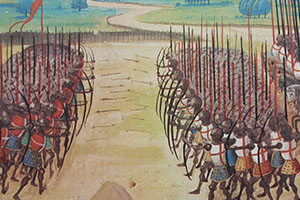
History-Conflict
The Military history of England

From Roman Wars to Afghanistan
Explore 2 thousand years of war

The Hundred Years' War was an arduous, sprawling conflict that dramatically shaped the destinies of two great European powers, England and France. Its origins were deeply rooted in the muddled intricacies of medieval feudalism, especially concerning the legitimate succession to the French throne. Upon the death of the last Capetian king of France, Charles IV, in 1328, Edward III of England emerged as a potential successor due to his close blood ties. However, relying on the Salic law, which sidelined female succession, the French crown went to Philip VI, marking the start of the Valois dynasty.
Edward III initially appeared to accept this transition, but territorial disputes in Gascony and conflicting interests in the Low Countries exacerbated old tensions. By 1337, overt hostilities began. In 1340, England claimed its first major victory at the naval Battle of Sluys. Commanded by Edward III, the English fleet devastated the French navy, cementing English dominance over the Channel. Six years later, the English forces, utilising the devastating power of the longbow to its fullest, inflicted a crushing defeat upon the French at the Battle of Crécy. Philip VI's forces were ill-prepared for the English tactics, and the outcome reaffirmed English military prowess. Following this triumph, Edward III laid siege to Calais in 1346. By 1347, the city surrendered and it became an English enclave for the next two centuries.
Yet the 1340s brought more than just warfare. The Black Death, a devastating pandemic, swept across Europe in 1348, pausing the conflict momentarily. When the deathly grip of the plague began to wane, hostilities resumed with renewed vigour. The Battle of Poitiers in 1356 was another shining testament to English military might. The French king, John II, found himself captured by the forces led by Edward's son, the Black Prince. This monumental event led to the Treaty of Brétigny in 1360. France ceded significant territories in the southwest, and in return, Edward renounced his claims to the French crown.
However, such treaties in these turbulent times were fragile. The ascension of Charles V in France brought a change in tactics. With the skilled commander, Bertrand du Guesclin, by his side, Charles V favoured sieges and guerrilla warfare, circumventing open battles. By 1389, much of the territory lost in the Treaty of Brétigny had been painstakingly reclaimed by France. England, meanwhile, found its attention diverted by internal political challenges.
The dawn of the 15th century brought a renewed English vigour in the form of Henry V. He not only resuscitated the English claim to the French throne but also led his forces to a resounding victory at the Battle of Agincourt in 1415. Against overwhelming odds, the English longbowmen were the linchpin to this remarkable success. The momentum was so firmly with the English that by 1420, the Treaty of Troyes declared Henry V the rightful heir to the French throne, casting aside the Dauphin, Charles VII.
However, fortunes shift like the sands of time. The latter stages of the war saw the rise of the indomitable Joan of Arc. Her spirited involvement was crucial in lifting the Siege of Orléans in 1429, tilting the balance in favour of the French. Riding this wave of success, Charles VII was crowned in Reims. Though Joan was captured by allies of the English and subsequently executed, her death was but a spark that ignited the flames of French resistance. By the mid-15th century, as England grappled with its own civil strife in the form of the War of the Roses, the French managed to reclaim almost all territories, leaving England with only Calais.
By 1475, the protracted hostilities found their official conclusion in the Treaty of Picquigny. England, having lost most of its territorial gains in France, pivoted towards its maritime ambitions, eventually setting the stage for its future as a naval superpower. France, having faced down the relentless English campaigns, set forth on its path to consolidate and centralise its vast territories, ensuring its status as a dominant continental force. The Hundred Years' War, while neither confined to a single stretch of conflict nor exactly lasting a hundred years, remains a poignant reminder of the relentless spirit of nations and the relentless progression of history.
If you have a suggestion regarding additional topics you would like to see included - please let us know
Reference: Article by Greg Scott (Staff Historian), 2024
